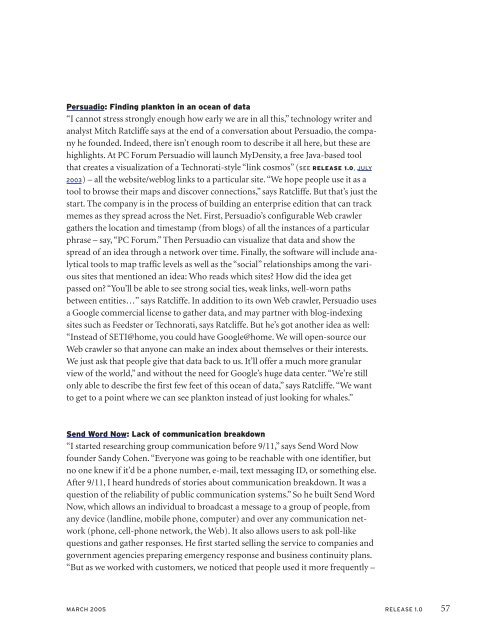The World Wide World: IT Ain't Just the Web ... - Cdn.oreilly.com
The World Wide World: IT Ain't Just the Web ... - Cdn.oreilly.com
The World Wide World: IT Ain't Just the Web ... - Cdn.oreilly.com
You also want an ePaper? Increase the reach of your titles
YUMPU automatically turns print PDFs into web optimized ePapers that Google loves.
Persuadio: Finding plankton in an ocean of data<br />
“I cannot stress strongly enough how early we are in all this,” technology writer and<br />
analyst Mitch Ratcliffe says at <strong>the</strong> end of a conversation about Persuadio, <strong>the</strong> <strong>com</strong>pany<br />
he founded. Indeed, <strong>the</strong>re isn’t enough room to describe it all here, but <strong>the</strong>se are<br />
highlights. At PC Forum Persuadio will launch MyDensity, a free Java-based tool<br />
that creates a visualization of a Technorati-style “link cosmos” (SEE RELEASE 1.0, JULY<br />
2003) – all <strong>the</strong> website/weblog links to a particular site. “We hope people use it as a<br />
tool to browse <strong>the</strong>ir maps and discover connections,” says Ratcliffe. But that’s just <strong>the</strong><br />
start. <strong>The</strong> <strong>com</strong>pany is in <strong>the</strong> process of building an enterprise edition that can track<br />
memes as <strong>the</strong>y spread across <strong>the</strong> Net. First, Persuadio’s configurable <strong>Web</strong> crawler<br />
ga<strong>the</strong>rs <strong>the</strong> location and timestamp (from blogs) of all <strong>the</strong> instances of a particular<br />
phrase – say, “PC Forum.” <strong>The</strong>n Persuadio can visualize that data and show <strong>the</strong><br />
spread of an idea through a network over time. Finally, <strong>the</strong> software will include analytical<br />
tools to map traffic levels as well as <strong>the</strong> “social” relationships among <strong>the</strong> various<br />
sites that mentioned an idea: Who reads which sites? How did <strong>the</strong> idea get<br />
passed on? “You’ll be able to see strong social ties, weak links, well-worn paths<br />
between entities…” says Ratcliffe. In addition to its own <strong>Web</strong> crawler, Persuadio uses<br />
a Google <strong>com</strong>mercial license to ga<strong>the</strong>r data, and may partner with blog-indexing<br />
sites such as Feedster or Technorati, says Ratcliffe. But he’s got ano<strong>the</strong>r idea as well:<br />
“Instead of SETI@home, you could have Google@home. We will open-source our<br />
<strong>Web</strong> crawler so that anyone can make an index about <strong>the</strong>mselves or <strong>the</strong>ir interests.<br />
We just ask that people give that data back to us. It’ll offer a much more granular<br />
view of <strong>the</strong> world,” and without <strong>the</strong> need for Google’s huge data center. “We’re still<br />
only able to describe <strong>the</strong> first few feet of this ocean of data,” says Ratcliffe. “We want<br />
to get to a point where we can see plankton instead of just looking for whales.”<br />
Send Word Now: Lack of <strong>com</strong>munication breakdown<br />
“I started researching group <strong>com</strong>munication before 9/11,” says Send Word Now<br />
founder Sandy Cohen. “Everyone was going to be reachable with one identifier, but<br />
no one knew if it’d be a phone number, e-mail, text messaging ID, or something else.<br />
After 9/11, I heard hundreds of stories about <strong>com</strong>munication breakdown. It was a<br />
question of <strong>the</strong> reliability of public <strong>com</strong>munication systems.” So he built Send Word<br />
Now, which allows an individual to broadcast a message to a group of people, from<br />
any device (landline, mobile phone, <strong>com</strong>puter) and over any <strong>com</strong>munication network<br />
(phone, cell-phone network, <strong>the</strong> <strong>Web</strong>). It also allows users to ask poll-like<br />
questions and ga<strong>the</strong>r responses. He first started selling <strong>the</strong> service to <strong>com</strong>panies and<br />
government agencies preparing emergency response and business continuity plans.<br />
“But as we worked with customers, we noticed that people used it more frequently –<br />
MARCH 2005 RELEASE 1.0 57
















